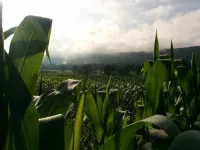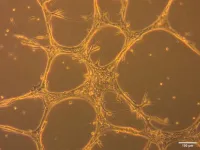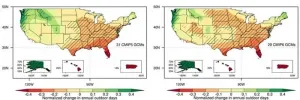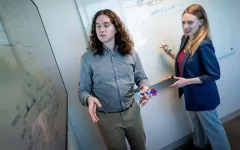(Press-News.org) UNIVERSITY PARK, Pa. — As climate change worsens global drought conditions, hindering crop production, the search for ways to capture and store atmospheric carbon causing the phenomenon has intensified. Penn State researchers have developed a new high-tech tool that could spur changes in how crops withstand drought, acquire nitrogen and store carbon deeper in soil.
In findings published in the January issue of Crop Science, they describe a process in which the depth of plant roots can be accurately estimated by scanning leaves with X-ray fluorescence spectroscopy, a process that detects chemical elements in the foliage. The method recognizes that roots take up elements they encounter, depending on the depth they reach, and a correlation exists between chemical elements in the leaves and root depth.
The new technology is the subject of a provisional patent application by Penn State, because it promises to speed up the plant-breeding process, according to research team leader Jonathan Lynch, distinguished professor of plant science in the College of Agricultural Sciences. The ability to measure the depth of plant roots without excavating them is a game-changing technology, he said.
“We've known about the benefits of deeper rooting crops for a long time — they are more drought tolerant and have an enhanced ability to take up nitrogen, which tends to move deep with water — but the problem has been how to measure root depth in the field,” he said. “To breed deeper-rooted crops, you need to look at thousands of plants. Digging them up is expensive and time consuming because some of those roots are down two meters or more. Everybody wants deep-rooted crops — but until now, we didn’t know how to get them.”
An added benefit to deeper-rooting crops, Lynch noted, is that they store carbon in the soil more effectively. And soil is the right place to put carbon, he pointed out, because carbon in the atmosphere is a bad thing — it causes global warming. Carbon in the soil is a good thing — it boosts fertility.
“Having deeper roots means that carbon the plants get from photosynthesis is stored down deeper in the soil when they build roots. And the deeper carbon is put in the soil, the longer it stays in the soil,” he said. “The U.S. Department of Energy estimates that just having deep-rooted crops in America alone could offset years of our total carbon emissions. That’s huge — think about all the acres growing crops in America. If those roots grow just a little bit deeper, then we’re storing massive amounts of carbon deeper in the soil.”
Developing the new method — which the researchers called LEADER (Leaf Element Accumulation from DEep Root) — took six years and involved the collection and analysis of more than 2,000 soil core samples at four research sites across the country, noted Molly Hanlon, a former postdoctoral scholar in Lynch’s research group, who spearheaded the study.
It involved growing a set of 30 genetically distinct lines of corn at Penn State’s Russell E. Larson Agricultural Research Center, the University of Colorado’s Agricultural Research and Education Center, the University of Wisconsin Arlington Agricultural Research Station, and the University of Wisconsin Hancock Agricultural Research Station. The researchers found that they could correctly classify the plots with the longest deep root lengths — deeper than 30 or 40 centimeters — using the LEADER method with high accuracy.
A major tenet of soil science is that biological, physical and chemical properties vary with soil depth, explained Hanlon, now a senior research scientist with Donald Danforth Plant Science Center in St. Louis.
“And plant roots grow through these different soil layers,” she said. “The elements are then transported to the shoot where we can quickly and easily assay the elemental content of leaf tissue using X-ray fluorescence. In this way, the leaves can serve as indicators or sensors of where the roots are in the soil.”
In the study, the researchers were able to accurately estimate root depth by analyzing the foliar accumulation of elements naturally occurring in diverse soils. As an alternative method for assessing root depth, in both field and greenhouse experiments, they injected strontium into the soil at a set depth as a tracer for LEADER analysis. Later, they harvested plants growing nearby and determined that strontium detected in the leaves strongly correlated to the depth of their roots.
Although the LEADER method was accomplished with corn, it offers a wider application, Lynch suggested.
“It shows promise as a tool for measuring root depth in different plant species and soils,” he said. “It made sense to do this research with corn — it’s one of the world’s most important crops, grown extensively as a staple food for humans, livestock feed, as a biofuel and as a starting material in industry. Deeper-rooted corn crops able take up more water and nitrogen under limiting conditions, with increased long-term soil carbon storage would be a major development. But this LEADER method can be used with all plants.”
Kathleen Brown, Penn State professor emeritus of plant stress biology, contributed to the research.
This research was funded by the U.S. Department of Energy ARPA-e and the U.S. Department of Agriculture’s National Institute of Food and Agriculture.
END
Novel method to measure root depth may lead to more resilient crops
New approach could lead to faster breeding of plants better able to withstand drought, acquire nitrogen and store carbon deeper in soil
2024-03-21
ELSE PRESS RELEASES FROM THIS DATE:
Scientists develop catalyst designed to make ammonia production more sustainable
2024-03-21
Ammonia is one of the most widely produced chemicals in the world, and is used in a great many manufacturing and service industries. The conventional production technology is the Haber-Bosch process, which combines nitrogen gas (N2) and hydrogen gas (H2) in a reactor in the presence of a catalyst. This process requires high levels of temperature and pressure, resulting in substantial power consumption. Indeed, ammonia production is estimated to consume 1%-2% of the world’s electricity and to account for about 3% of global carbon emissions.
In pursuit of more sustainable alternatives, researchers affiliated with the Center for Development of Functional Materials (CDMF) ...
Forest, stream habitats keep energy exchanges in balance, global team finds
2024-03-21
UNIVERSITY PARK, Pa. — Forests and streams are separate but linked ecosystems, existing side by side, with energy and nutrients crossing their porous borders and flowing back and forth between them. For example, leaves fall from trees, enter streams, decay and feed aquatic insects. Those insects emerge from the waters and are eaten by birds and bats. An international team led by Penn State researchers has now found that these ecosystems appear to keep the energy exchanges in balance — a finding that the scientists called surprising.
Scientists ...
Product that kills agricultural pests also deadly to native Pacific Northwest snail
2024-03-21
CORVALLIS, Ore. – A product used to control pest slugs on farms in multiple countries is deadly to least one type of native woodland snail endemic to the Pacific Northwest, according to scientists who say more study is needed before the product gains approval in the United States.
Dee Denver of the Oregon State University College of Science led a 10-week laboratory project that showed the effect of a biotool marketed as Nemaslug on the Pacific sideband snail. The study was published today in PLOS One.
Nemaslug is based on the organism Phasmarhabditis hermaphrodita, a species of tiny, parasitic worm known as a nematode.
The ...
Two keys needed to crack three locks for better engineered blood vessels
2024-03-21
UNIVERSITY PARK, Pa. — Blood vessels engineered from stem cells could help solve several research and clinical problems, from potentially providing a more comprehensive platform to screen if drug candidates can cross from the blood stream into the brain to developing lab-grown vascular tissue to support heart transplants, according to Penn State researchers. Led by Xiaojun “Lance” Lian, associate professor of biomedical engineering and of biology, the team discovered the specific molecular signals that can efficiently mature nascent stem cells into the endothelial cells that comprise the vessels and regulate exchanges to and ...
UTEP faculty launch research lab to support human performance
2024-03-21
EL PASO, Texas (Mar. 21, 2024) - Professors at The University of Texas at El Paso have launched a new industrial engineering lab focused on supporting human performance and behavior in various application areas. Projects include supportive exoskeletons for high-strain occupations and virtual reality that simulates high-stress environments.
The facility, known as the Physical, Information and Cognitive Human Factors Engineering (PIC-HFE) Research Lab, was established with the help of a $350,000 STAR grant from the State of Texas.
The lab is led by Priyadarshini Pennathur, Ph.D., and Arunkumar ...
Improving & maintaining heart health after pregnancy may reduce the risk of future CVD
2024-03-21
Research Highlights:
An analysis of health records for almost 110,000 women in the U.K. found that women with poor cardiovascular health after pregnancy or who experienced adverse pregnancy outcomes, including high blood pressure, gestational diabetes and/or pre-term birth, had a significantly higher long-term risk of developing cardiovascular disease.
Among women with adverse pregnancy outcomes, those who maintained better cardiovascular health after pregnancy had cardiovascular disease risk similar to women who had no history of pregnancy complications.
Embargoed until 1:30 p.m. CT/2:30 ...
New generation estrogen receptor-targeted agents in breast cancer
2024-03-21
https://www.scienceopen.com/hosted-document?doi=10.15212/AMM-2024-0006
Announcing a new publication for Acta Materia Medica journal. Endocrine therapy that blocks estrogen receptor signaling has been effective for decades as a primary treatment choice for breast cancer patients expressing the estrogen receptor. However, the issue of drug resistance poses a significant clinical challenge. It is therefore critically important to create new therapeutic agents that can suppress ERα activity, particularly in cases of ESR1 mutations. This review article highlights recent efforts in drug development of next ...
A new way to quantify climate change impacts: “Outdoor days”
2024-03-21
For most people, reading about the difference between a global average temperature rise of 1.5 C versus 2 C doesn’t conjure up a clear image of how their daily lives will actually be affected. So, researchers at MIT have come up with a different way of measuring and describing what global climate change patterns, in specific regions around the world, will mean for people’s daily activities and their quality of life.
The new measure, called “outdoor days,” describes the number of days per year that outdoor temperatures are neither too ...
Scientists find core regulatory circuit controlling identity of aggressive leukemia
2024-03-21
A collaboration between scientists from St. Jude Children’s Research Hospital and Dana-Farber Cancer Institute uncovered four proteins that govern the identity of anaplastic large cell lymphoma (ALCL), an aggressive form of cancer. These proteins comprise a core regulatory circuit (CRC) that surprisingly incorporates a dysregulated signaling protein. Establishing the CRC for this lymphoma gives researchers insight into potential vulnerabilities that may be future therapeutic targets. The findings were published today in Cell Reports Medicine.
“Mutations in signaling pathways have long been known to drive oncogenic transformation ...
Organic fields increase pesticide use in nearby conventional fields, but reduce it in organic neighbors
2024-03-21
Expanding organic cropland can lead to increased pesticide use in surrounding conventional fields while reducing pesticide use on nearby organic fields, according to a study based in a leading U.S. crop-producing region. The findings provide insight into overlooked environmental impacts of organic agriculture and suggest that clustering organic fields could reduce pesticide use at the landscape scale. Organic agricultural practices are designed to have less negative local environmental impacts than other forms of intensive agriculture. However, the ...
LAST 30 PRESS RELEASES:
Multichannel 3D-printed bioactive scaffold combined with siRNA delivery for spinal cord injury recovery
Triaptosis—an emerging paradigm in cancer therapeutics
A new paradigm in spectroscopic sensing: The revolutionary leap of SERS-optical waveguide integration and ai-enabled ultra-sensitive detection
Sweet tooth: How blood sugar migration in diabetes affects cavity development
Lowest suicide rate is in December but some in media still promote holiday-suicide myth
Record-breaking cosmic explosion challenges astronomers’ understanding of gamma-ray bursts
Excessive heat harms young children’s development, study suggests
Quanta Books to publish popular math and physics titles by Terence Tao and David Tong
Philanthropic partnerships fund next-generation instruments for mid-sized telescopes
AI offers ‘roadmap’ to plant genetics
Myosin XI-1: A key molecular target for salt-tolerant crops
Pusan National University study highlights the health hazards of ultrafine particles from small home appliances with electric heating coils and brushed DC motors
Global first: New Indigenous-led research initiative to revitalize legal orders
Transforming acoustic waves with a chip
When climate risk hits home, people listen: Study reveals key to engagement with disaster preparedness messaging
Major breakthrough against diabetes thanks to a microbial molecule that disarms inflammation
Silicon chips on the brain: Researchers announce a new generation of brain-computer interface
Getting rest is the best
Towards sustainable organic synthesis – Mechanochemistry replaces lithium with sodium in organic reactions
Wireless device ‘speaks’ to the brain with light
Greenhouse gases to intensify extreme flooding in the Central Himalayas
New study sheds light on Milky Way's mysterious chemical history
Could altering the daily timing of immunotherapy improve survival in people with cancer?
Weaving secondary battery electrodes with fibers and tying them like ropes for both durability and performance
Using social media may impair children’s attention
Science briefing: An update on GLP-1 drugs for obesity
Lower doses of immunotherapy for skin cancer give better results
Why didn’t the senior citizen cross the road? Slower crossings may help people with reduced mobility
ASH 2025: Study suggests that a virtual program focusing on diet and exercise can help reduce side effects of lymphoma treatment
A sound defense: Noisy pupae puff away potential predators
[Press-News.org] Novel method to measure root depth may lead to more resilient cropsNew approach could lead to faster breeding of plants better able to withstand drought, acquire nitrogen and store carbon deeper in soil







